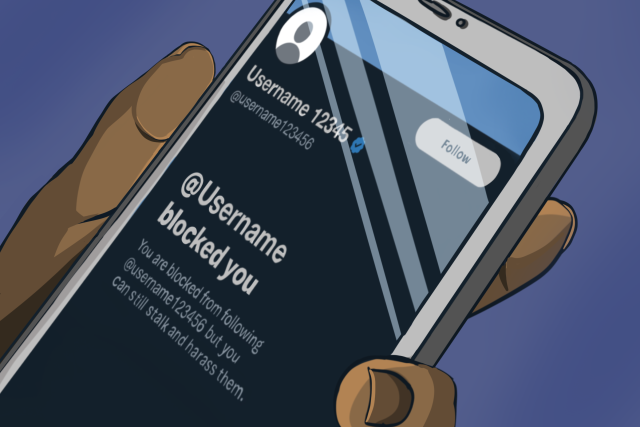[ad_1]
On Monday, Sept. 23, an X post announced that the platform would be removing the “block” button. X CEO Elon Musk felt the need to reply to the post, saying that it was “high time” that the function went away. Musk’s confirmation of this change marks yet another major modification to X during his tenure. Previous changes include privatizing of likes, allowing users to buy a verification “checkmark” and, most glaringly, renaming the platform “X.” Musk’s decision to remove the current iteration of the block button, a tool used to protect users from dangerous posts or people, signifies the industry mogul’s desire to create a social media platform that prioritizes his personal desires over user safety.
The block button is a social media staple. It serves as the last line of defense for users looking to avoid something or someone in the digital space, whether it’s a relationship gone wrong, online harassment or stopping spam on their feed. Social media is better off with the ability to block. When X removes the function, users will no longer be able to use it for safety or convenience.
X’s revised block button will allow blocked users to see the posts from users who blocked them, but not directly interact. The revision streamlines a previously available loophole to blocked users, which allowed them to view users who blocked them using a separate account. For X, this is part of their purported reasoning for the change. Now, blocked users know exactly when their blocker posts, and can use a separate account to interact.
Musk has also alluded to mass block lists and campaigns creating technical issues, claiming that they create Distributed Denial of Service vectors. However, much of this antiblocking sentiment appears to come from the annoyance posed by those users who purchased verification. These users are being blocked at high rates due to their flooding of the “replies” section and timelines. With many accounts blocking those paying users, Musk seems to be concerned about putting the company at risk of losing them if their posts aren’t as visible.
Although streamlining an existing process and reducing technical issues appears to be the main motivation behind the change, Musk’s self-proclaimed free-speech absolutist views likely influenced the change as well. As X’s owner, Musk has effectively changed the platform to become a bastion for online free speech. His attitudes are a reactionary attempt to appeal to the politicians and policymakers who have criticized platforms like Facebook and YouTube for their direct involvement in censoring and removing users for certain content posted on their respective platforms.
But Musk’s crusade is hypocritical. The number of suspended X users has increased under Musk’s leadership. At the same time, he has refused to suspend specific accounts as requested by the Brazilian government has led to X being banned in the country.
But the most damning thing about Musk’s decision is not its hypocrisy, but his blatant yearning for power. The new system gives Musk the ability to see the posts from those who have blocked him — allowing him to punish them if they speak out against his ownership or rhetoric. Musk has shown a propensity to change how the platform operates to favor him before, with allegations that he demanded that the algorithm give his account greater visibility after a post of his received less likes than a similar one made by President Joe Biden. The change to the block function makes more sense as a policy change Musk directly ordered due to rumors that many users have him blocked on the platform. All of this comes as changes in X’s policy, such as verification and regulation of speech, have rapidly moved to support users and ideologies that Musk has backed, despite Musk’s claim that the platform would remain politically neutral.
Regardless of what influenced the change to how the blocking function works on X, the change is dangerous because it streamlines a process that once made it difficult for banned users to see content not intended for them. Although alternatives existed for these users, not having an additional account for X would typically bar them from accessing the account’s page. X’s new policy will thus benefit bad actors on the platform, since they no longer have to go through the process of creating a new account.
In addition, X still allows direct interaction between blocked accounts and the user who blocked them, which acts as a dangerous loophole. Keeping direct interaction off in the new ban function merely allows the platform to claim that action is being taken despite the policy acting as nothing more than a glorified mute button.
X’s change removes both the formal and informal barriers to online harassment and allows previously deterred users to engage in dangerous behavior on the platform. While intentions aren’t always clear when it comes to social media policy changes, the decision to change how banning works on a platform with hundreds of millions of users is nothing more than a power-hungry move by a man who wants it all — even if he has to compromise safety to get there.
Thomas Muha is an Opinion Columnist and can be reached at tmuha@umich.edu. His column “Internet Insight” discusses the legal and economic issues facing the internet today.
Related articles
[ad_2]
Source link











